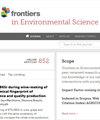Combined toxicity of multiwall carbon nanotubes and cadmium on rice (Oryza sativa L.) growth in soil
IF 3.3
3区 环境科学与生态学
Q2 ENVIRONMENTAL SCIENCES
引用次数: 0
Abstract
The comprehensive effects of nanoparticles and coexisting heavy metals on plant growth are still unclear, especially in soil medium. The single and combined effects of multiwall carbon nanotubes (MWCNTs) and cadmium (Cd) on rice (多壁碳纳米管和镉对土壤中水稻(Oryza sativa L.)生长的联合毒性
纳米颗粒和共存重金属对植物生长的综合影响尚不明确,尤其是在土壤介质中。本研究通过在 2022 年进行为期 4 个月的盆栽实验,考察了多壁碳纳米管(MWCNTs)和镉(Cd)对水稻(Oryza sativa L.)生长的单一影响和综合影响。在 5.0 mg kg-1 Cd 胁迫下,水稻植株暴露于不同浓度的 MWCNTs(100 和 500 mg kg-1)。在分蘖期,添加 500 毫克千克-1 的 MWCNTs 会使植株高度降低 8.0%,叶片中的可溶性蛋白质含量增加 13.7%,这表明单一 MWCNTs 对水稻生长有轻微的负面影响。当受到镉胁迫时,加入 500 毫克/千克-1 的 MWCNTs 可使土壤中的生物可利用镉含量降低 6.7%-9.0%,从而使根部(23.4%-29.9%)、芽(24.5%-28.3%)和谷粒(28.3%-66.2%)中的镉含量大幅降低。与单一镉处理相比,经镉和 MWCNTs(500 毫克/千克)处理的 O. sativa L. 叶片的丙二醛(MDA)、可溶性蛋白质和抗氧化酶(POD、CAT 和 SOD)活性水平显著降低。该研究结果表明,在土壤中施用适当浓度的 MWCNTs 可减轻镉对水稻生长的毒性。
本文章由计算机程序翻译,如有差异,请以英文原文为准。
求助全文
约1分钟内获得全文
求助全文
来源期刊

Frontiers in Environmental Science
Environmental Science-General Environmental Science
CiteScore
4.50
自引率
8.70%
发文量
2276
审稿时长
12 weeks
期刊介绍:
Our natural world is experiencing a state of rapid change unprecedented in the presence of humans. The changes affect virtually all physical, chemical and biological systems on Earth. The interaction of these systems leads to tipping points, feedbacks and amplification of effects. In virtually all cases, the causes of environmental change can be traced to human activity through either direct interventions as a consequence of pollution, or through global warming from greenhouse case emissions. Well-formulated and internationally-relevant policies to mitigate the change, or adapt to the consequences, that will ensure our ability to thrive in the coming decades are badly needed. Without proper understanding of the processes involved, and deep understanding of the likely impacts of bad decisions or inaction, the security of food, water and energy is a risk. Left unchecked shortages of these basic commodities will lead to migration, global geopolitical tension and conflict. This represents the major challenge of our time. We are the first generation to appreciate the problem and we will be judged in future by our ability to determine and take the action necessary. Appropriate knowledge of the condition of our natural world, appreciation of the changes occurring, and predictions of how the future will develop are requisite to the definition and implementation of solutions.
Frontiers in Environmental Science publishes research at the cutting edge of knowledge of our natural world and its various intersections with society. It bridges between the identification and measurement of change, comprehension of the processes responsible, and the measures needed to reduce their impact. Its aim is to assist the formulation of policies, by offering sound scientific evidence on environmental science, that will lead to a more inhabitable and sustainable world for the generations to come.
 求助内容:
求助内容: 应助结果提醒方式:
应助结果提醒方式:


